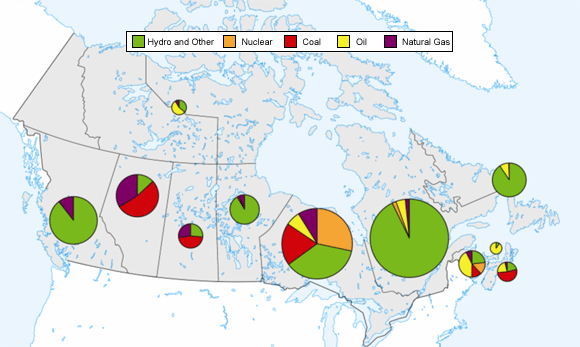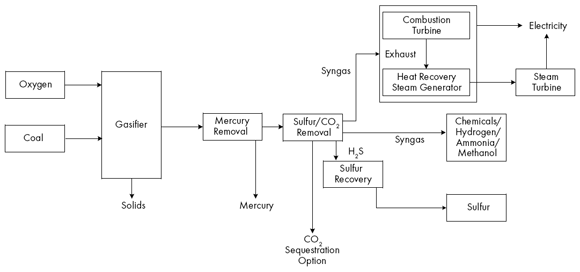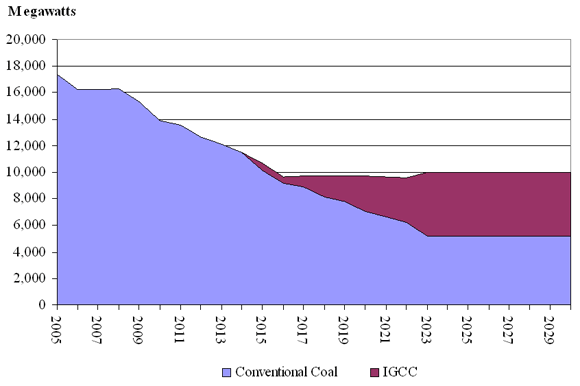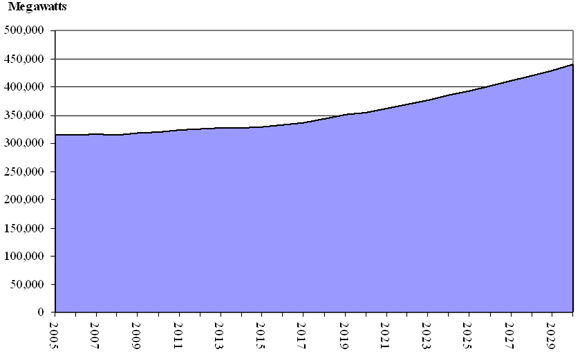ARCHIVED - Coal-Fired Power Generation: A Perspective - Energy Briefing Note
This page has been archived on the Web
Information identified as archived is provided for reference, research or recordkeeping purposes. It is not subject to the Government of Canada Web Standards and has not been altered or updated since it was archived. Please contact us to request a format other than those available.
ISSN 1914-4822
Coal-Fired Power Generation: A Perspective - Energy Briefing Note [PDF 212 KB]
July 2008
Table of Contents
Foreword
Introduction
Coal-Fired Generation in North America
Strengths and Weaknesses of Coal
Technological Developments
Coal-Fired Generation Trends
Observations
Appendix 1
Appendix 2
Foreword
The National Energy Board (NEB or the Board) is an independent federal agency that regulates several aspects of Canada's energy industry. Its purpose is to promote safety and security, environmental protection and efficient energy infrastructure and markets in the Canadian public interest[*] within the mandate set by Parliament in the regulation of pipelines, energy development and trade. The Board's main responsibilities include regulating the construction and operation of interprovincial and international oil and gas pipelines as well as international and designated interprovincial power lines. The Board regulates pipeline tolls and tariffs for pipelines under its jurisdiction. In terms of specific energy commodities, the Board regulates the exports and imports of natural gas as well as exports of oil, natural gas liquids (NGLs) and electricity. Additionally, the Board regulates oil and gas exploration, development and production in Frontier lands and offshore areas not covered by provincial or federal management agreements. The Board's advisory function requires keeping under review matters over which Parliament has jurisdiction relating to all aspects of energy supply, transmission and disposal of energy in and outside Canada.
The NEB monitors energy markets to objectively analyze energy commodities and inform Canadians about trends, events and issues. The Board releases numerous research reports. This report is a briefing note - a brief report covering one aspect of energy commodities. Specifically, this report examines the role of coal-fired electrical generation in Canada, with reference to the situation in the United States.
If a party wishes to rely on material from this report in any regulatory proceeding before the NEB, it may submit the material, just as it may submit any public document. Under these circumstances, the submitting party in effect adopts the material and that party could be required to answer questions pertaining to the material.
Introduction
This briefing note provides an overview of the role of coal in electrical generation in Canada, and with reference to the situation in the United States. The National Energy Board (NEB) collects and analyses information about Canadian energy markets through regulatory processes and market monitoring. From these efforts, the Board publishes information such as the report on Canada's Energy Futures, several Energy Market Assessments, statistical reports, briefing notes and public presentations that address various market aspects of Canada's energy commodities.
Coal-Fired Generation in North America
Coal-fired generation represents about 13 per cent of the installed power generation capacity in Canada, and accounted for nearly 17 per cent of the electric energy produced in 2006. Coal-fired generation is not evenly distributed across Canada (Figure 1), being found predominantly in Alberta, Saskatchewan, Ontario, New Brunswick and Nova Scotia, all provinces where there is relatively less hydro power available.
Figure 1: Canadian Installed Generating Capacity - 2006*

* Supplemental data provided in Appendix 1
The market shares of various fuels for power generation vary significantly between Canada and the U.S. (Table 1). In Canada, hydro represents the majority of the installed capacity and generation, whereas coal and natural gas fired generation are the two most important sources of electricity in the United States. There, coal represents 32 per cent of the installed generating capacity, but accounts for nearly half of the electricity produced. By comparison, Canada has about one twentieth the amounts of coal-fired generation and installed capacity.
Table 1: 2006 Generating Capacity and Output by Fuel Type - Canada and the United States
| Fuel Type | Installed Capacity Megawatts (per cent of total) |
Generation Terawatt-hours (per cent of total) |
||
|---|---|---|---|---|
| Canada | United States | Canada | United States | |
Hydro and Other* |
75> 965 |
124> 650 |
361.3 |
409.1 |
Nuclear |
13> 345 |
100> 209 |
92.4 |
787.2 |
Coal |
16 272 |
313 774 |
97.6 |
1990.9 |
Oil |
7 225 |
142 063 |
8.6 |
64.4 |
Natural Gas |
10 896 |
302 171 |
30.8 |
813.0 |
Total |
123 792 |
982 867 |
590.7 |
4064.7 |
* Other includes wind, wave/tidal, solar, biomass and other gas fuels such as propane, waste, and manufactured gas.
Sources: Statistics Canada, U.S. Energy Information Administration
Strengths and Weaknesses of Coal
Coal-fired generation has a number of advantages that make it a desirable source of electricity. It is a reliable, mature technology, and is well understood by the traditional producers of electricity. Further, while there is an international market for thermal coal, historically coal prices have been lower and less volatile than oil and natural gas prices. World coal reserves are higher and more distributed than those of oil and natural gas, as is also the case in North America, so there is also less geopolitical uncertainty about coal than there is about other fossil fuels[1]. Many power generation plants, particularly those in Western Canada, are located adjacent to a coal mine, which facilitates secure and long-term fuel supply arrangements.
[1] The composition of hydrocarbon reserves on an energy equivalent basis in the U.S. and Canada combined is about 91 per cent coal, 4 per cent gas and 5 per cent oil. In Canada alone, the composition is about 44 per cent coal, 15 per cent gas and 41 per cent oil (Source: BP Statistical Review of World Energy, June 2008).
In power systems, the electricity produced must always equal the electricity consumed, because once produced, electricity cannot be economically stored. This balance of supply and demand must be maintained even as power demand varies throughout the day and year. While coal-fired generation is capable of following the load changes to a certain extent, it is ideally suited and economically attractive for base load generation. Hydro power and natural gas fired generation can more easily follow load changes.
Coal-fired generation also faces a number of challenges. Coal-fired power plants require more capital investment, take longer to build than natural gas-fired generation, and enjoy economies of scale that make it advantageous to build the largest coal plant consistent with the size of the electrical system. The longer lead times can increase the chance of a mismatch between the date a new coal-fired plant enters service and the date it is needed to meet growing demand. Coal is also harder to transport than natural gas, so coal plants must be sited near a mine, a deep-water port or a rail line.
There is also public concern about the environmental effects of the emissions from coal-fired generation. Modern Canadian plants can minimize emissions by: using advanced burners to control the production of the various oxides of nitrogen (NOX); installing precipitators and scrubbers to remove pollutants; and having access to low sulphur coal, like generating plants in Alberta and Saskatchewan, which minimizes production of oxides of sulphur (SOX). However, coal-fired power plants still have higher emissions than gas-fired generation. In particular, the lower overall efficiency of coal-fired power plants compared to modern combined-cycle gas-fired generation and the higher carbon content of coal compared to natural gas means that coal-fired power plants have higher Greenhouse Gas (GHG) emissions than natural-gas fired combined-cycle power plants. Depending on the plant technology, gas-fired power generation produces 40-50 per cent fewer emissions than a coal-fired facility for the same amount of electricity produced.
Another concern is the release of heavy metals, such as mercury, found as trace elements in the coal. Uncertainty about possible direction of future environmental regulation has discouraged new investment in coal-fired generation.
Technological Developments
Coal-fired generation technology has not stood still. The term “clean coal” is often used, sometimes to refer to state of the art conventional facilities, and sometimes reserved for new methods using coal.
The most recent coal-fired generator to be built in Canada is the Genesee 3 unit, near Edmonton, Alberta, which went into commercial operation on 1 March 2005. Genesee 3 is the first power plant in the country to use supercritical-pressure pulverized coal combustion technology. Almost all coal-fired generators use pulverized coal combustion technology, where the coal is ground to a fine powder before being burned to allow for more complete combustion. Genesee 3, unlike older units, heats water to supercritical temperature and pressure in its steam boiler, an advance that increases the efficiency of the power plant, reducing fuel consumption (and associated GHG emissions) by about 18 per cent compared to older coal-fired power plants. The unit is fitted with pollution control equipment and the operator has committed to buying carbon offsets to reduce the net GHG emissions from the facility to the level of a state of the art combined-cycle natural gas-fired facility.
While Genesee 3 is the first supercritical coal-fired unit in Canada, the technology is an evolutionary advancement of existing plants, and has been used in the United States, Europe and Asia. Thus supercritical coal-fired generation is seen as a low-risk option for new power plants.
Point Aconi, Nova Scotia is the only commercial fluidized bed power plant in Canada. This technology mixes limestone with the burning coal to absorb sulphur and, by reducing combustion temperature, reduces the formation of NOX. However, this lower temperature reduces overall efficiency so a fluidized bed plant will use slightly more fuel and produce slightly more carbon dioxide (CO2) than a supercritical coal-fired plant with the same electric output.
The other major option for advanced coal-fired generation is Integrated Gasification Combined Cycle (IGCC) technology. An IGCC power plant uses a gasifier to convert coal into synthesis gas, a mixture of carbon monoxide (CO) and hydrogen (H2), which is then used to fire the combustion turbine in a combined-cycle power plant. In addition to this improved efficiency in power production, the advantages of IGCC include the ability to scrub pollutants like sulphur and heavy metals from the fuel before it is burned. Higher efficiency results in lower fuel consumption and lower production of GHGs.
Figure 2: Schematic of a Typical IGCC Facility

Source: Emerging Technologies in Electricity Generation, NEB 2006
While a few IGCC pilot plants have been built in other countries, and the basic technologies of coal gasification and combined-cycle power plants have been proven separately, this particular combination is still new, raising uncertainty about construction costs and concerns about reliability. At present, the levelized unit cost of power generation is estimated at 15 to 20 per cent higher than the next best, supercritical coal-fired technology[2]. If sufficient experience is gained, either from plants in other countries or pilot projects in Canada, IGCC has the potential to become the preferred technology for generating electricity from coal.
[2] Source: Cambridge Energy Research Associates, 2008
Even with improved technology, GHG emissions are still a concern for coal-fired generation, so the potential for Carbon Capture and Storage (CCS) may have an important impact. There are a number of potential technologies for power plant CCS, which involve either scrubbing CO2 from the exhaust stream after combustion or removing it from the fuel before power is generated.
Post combustion scrubbing is less efficient, but it allows the plant to operate as a conventional facility if there are technical difficulties with the CO2 scrubbers. The OxyFuel process facilitates post-combustion CO2 scrubbing by enriching the oxygen content of the combustion air, reducing the volume that must be scrubbed per tonne of CO2.
Pre-combustion scrubbing typically involves combining CO2 capture with the gasification process in an IGCC plant. This is more efficient but makes the functioning of the plant dependent on the reliability of CO2 capture equipment.
Once the CO2 has been collected, it can then be shipped by pipeline to an area where it can be stored in geological formations such as active or depleted oil and gas reservoirs or deep saline aquifers. While there are potential sites for CO2 storage in or near most Canadian provinces, Alberta is seen a good candidate for CCS because it has large sources of high purity CO2 located in the vicinity of the Western Canadian Sedimentary Basin (WCSB). The geology of the WCSB is well understood and it has infrastructure in place that could be leveraged for CO2 transportation and injection. It also offers the possibility of using the CO2 for enhanced oil recovery (EOR), offsetting some of the cost of capturing and storing the CO2.
An important first step has been taken with the development of the Weyburn CO2 Monitoring and Storage Project. This project uses CO2 from the Dakota Gasification Company's Synfuels Plant in North Dakota, which is shipped by pipeline to the Weyburn Field in Saskatchewan, where it is used for EOR. While CO2 has been used in oil recovery before, this project includes monitoring the movement of CO2 in the reservoir. This will help determine the feasibility of long term geologic storage of CO2.
Potential technological developments can greatly reduce the environmental footprint of coal-fired generation. It remains to be seen whether this can be done in a manner that maintains coal-fired generation's cost advantage over other sources such as natural gas or nuclear generation.
Coal-Fired Generation Trends
Based on the NEB's 2007 Energy Futures Report, including updates to reflect announcements made since the report was prepared, a steady decline of coal-fired generation in Canada is projected from slightly over 16 000 MW to 10 000 MW in 2030. This includes a decline in conventional coal-fired generation due to the coal phase-out in Ontario and partially offset by the growth of IGCC in Alberta and Saskatchewan. Apart from Ontario, coal-fired power is expected to continue play a significant role in provinces where it is currently utilized (Appendix 1). Some notable developments follow.
Figure 3: Canadian Coal-Fired Generating Capacity

Source: Energy Futures Report - Continuing Trends Scenario, NEB 2007, adjusted to reflect subsequent announcements.
Currently, Alberta leads Canada in the development of new coal-fired generation. Keephills 3, a 450 megawatt (MW) power plant using the same supercritical-pressure pulverized coal combustion technology as Genesee 3, is currently under construction with an expected in-service date of early 2011. As well, there are planned capacity increases at a number of existing power plants in the province. On 12 October 2007 the Federal and Alberta governments undertook to partner with EPCOR Utilities Incorporated and the Canadian Clean Power Coalition (CCPC) in a $33 million research and development project that, if successful, could see a 500 MW IGCC plant in service as early as 2015.
Saskatchewan had been examining the possibility of a 300 MW clean coal power plant using the OxyFuel process, equipped to capture 90 per cent of the plant's CO2 emissions, but a combination of cost uncertainty and demand growing faster than expected led the province to opt for natural-gas fired combustion turbine generation instead. On 27 February 2008 the project was revived in a revised form when SaskPower announced plans to refurbish and retrofit the existing Boundary Dam Unit 3 coal-fired plant with CO2 capture technology. The new project could be ready by 2015 at the earliest and would generate about 100 MW.
Ontario currently has over 6 000 MW of installed coal-fired generation that it plans to retire by 2015 due to concern over coal's environmental effects. The Ontario Power Authority has developed a Coal Replacement Plan, included in its Integrated Power System Plan. This plan, reflected in Figure 3, depends on the planned return to service of nuclear units at the Bruce Generating station, the construction of new natural gas-fired generation, an increase in energy from renewable sources and the introduction of a “Conservation Culture” to mitigate future demand growth. Coal remains a significant source of electric generation in Ontario to that time, and serves as a backstop should any of the alternative sources be delayed. In that case, some of the coal units, especially those already fitted with scrubbers, might remain in service past 2015.
Alberta is also expected to see the retirement of up to 2 500 MW of its older existing coal units in the next 15 years, starting with the 280 MW Wabamun 4 unit in 2010, which will be replaced by the new Keephills 3 unit described above. The NEB outlook assumes that these units will be replaced by a combination of new coal units (mainly IGCC) and oil sands cogeneration, which is assumed to use natural gas or bitumen as a fuel. If proposed nuclear generation were built in Alberta this would reduce the potential for new coal-fired generation significantly, while a slow-down in the oil sands development could offer opportunity for more coal-fired generation.
Clean coal technologies can also be expected to play a role in New Brunswick and Nova Scotia over the next 20 years.
The latest U.S. Energy Information Administration study (Figure 4) predicts a net increase of coal-fired generating capacity of 124 300 MW between 2007 and 2030. There is considerable uncertainty in this outlook since, while a number of new coal plants have been proposed for the United States, local opposition to their construction and uncertainty about future environmental regulation, including carbon pricing, have led to the recent cancellation of some previously announced projects.
Figure 4: U.S. Coal-Fired Generating Capacity

Source: Annual Energy Outlook, U.S. Energy Information Administration 2008
Observations
Coal-fired generation is a significant component of the generation mix in Canada and the United States, and will continue to be so for the foreseeable future. On the other hand, coal faces challenges due to concerns about air quality, uncertainty about future GHG regulations and competition from other sources of generation such as renewables, natural gas and nuclear.
Any projection will be subject to considerable uncertainty until more is known about the direction of future GHG regulations, and the cost and reliability of new, clean coal technologies. If carbon sequestration and storage proves practical it would address a major concern about coal-fired generation and tend to promote the construction of new coal-fired power plants and associated CO2 pipelines.
Sources of additional information on issues related to coal-fired generation are listed in Appendix 2.
Appendix 1
Canadian Electric Generation Capacity - By Province and Territory
| Province/ Territory |
2006 | 2030 | ||||
|---|---|---|---|---|---|---|
| Total (MW) |
Coal-Fired (MW) |
Coal % | Total (MW) |
Coal-Fired (MW) |
Coal % | |
| B.C. | 14 828 | 0 | 0.0 | 19 589 | 0 | 0.0 |
| Alta. | 11 736 | 6 217 | 52.9 | 14 485 | 6 151 | 42.5 |
| Sask. | 3 879 | 1 800 | 46.4 | 4 841 | 1 485 | 30.7 |
| Man. | 5 629 | 98 | 1.7 | 9 480 | 98 | 1.0 |
| Ont. | 32 521 | 6 329 | 19.5 | 40 576 | 360 | 0.9 |
| Que. | 40 219 | 0 | 0.0 | 56 012 | 0 | 0.0 |
| N.B. | 4 549 | 541 | 11.9 | 5 228 | 840 | 16.1 |
| N.S. | 2 463 | 1 288 | 52.3 | 3 159 | 1 068 | 33.8 |
| P.E.I. | 171 | 0 | 0.0 | 550 | 0 | 0.0 |
| N.L. | 7 494 | 0 | 0.0 | 9 972 | 0 | 0.0 |
| Y.T., N.W.T, NU | 304 | 0 | 0.0 | 798 | 0 | 0.0 |
| Total | 123 792 | 16 272 | 13.1 | 164 689 | 10 002 | 6.1 |
Source:
2006: 57-206 Electric Power Generating Stations for 2006, Statistics Canada
2030: Energy Futures Report - Continuing Trends Scenario, adjusted to reflect subsequent announcements; NEB 2007
Appendix 2
Additional Information
The National Energy Board has produced a number of studies and Energy Market Assessments that relate to coal-fired generation. The following can be found on the NEB web site (www.neb-one.gc.ca) under Energy Reports:
- Canada's Energy Future - Reference Case and Scenarios to 2030 - Energy Market Assessment
- The Energy Futures Speakers Series has information on coal-fired generation and CCS technology
- The Emerging Technologies in Electricity Generation EMA has a discussion of clean coal technologies.
- There is also useful information on a number of other web sites:
- For information on energy in the U.S. refer to the U.S. Energy Information Administration
- The Coal Association of Canada has information about the coal industry in Canada
- The World Bank has undertaken a study of supercritical coal-fired generation
- Information on coal gasification and IGCC is provided at clean-energy.us
- SaskPower Clean Coal Project Announcement
- Alberta IGCC announcement
- Weyburn CO2 Monitoring and Storage Project
- Date modified:
